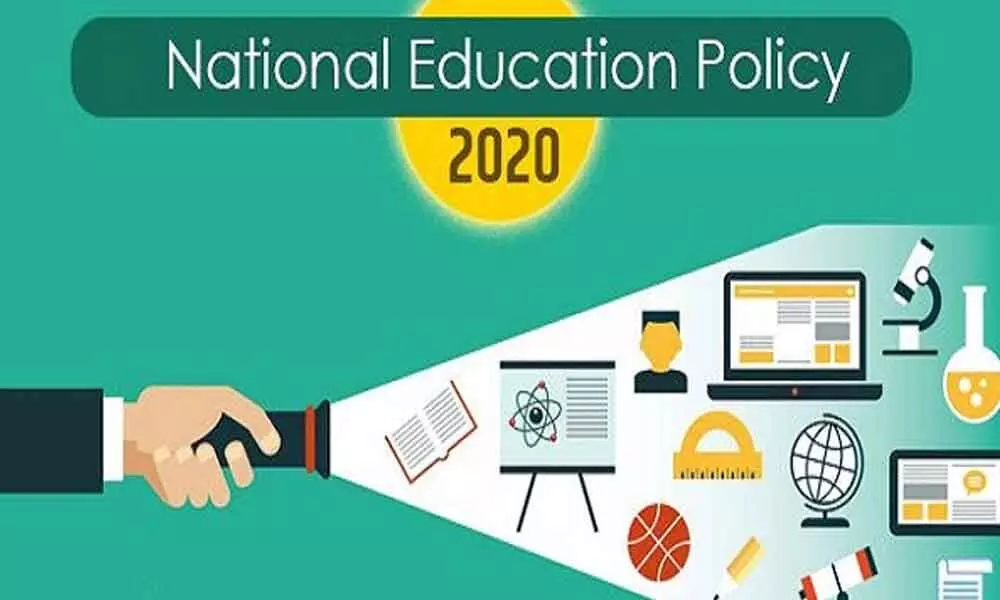Gender in National Education Policy 2020

Gender in National Education Policy 2020
There is a need to understand impact of the National Education Policy 2020 on higher education in India from a gendered lens. The policy document, released after being in the making for almost five years, aims to undertake a “complete overhaul and re-energising of the higher education system”.
There is a need to understand impact of the National Education Policy 2020 on higher education in India from a gendered lens. The policy document, released after being in the making for almost five years, aims to undertake a "complete overhaul and re-energising of the higher education system".
Many targets are laid out including one of enhancing the Gross Enrolment Ratio (GER) in higher education to 50 per cent by the year 2035. The document lists out several challenges such as severe fragmentation, rigid separation of disciplines, limited access, limited decentralised autonomy, ineffective regulation and low emphasis on research, among others.
To tackle these issues, it makes many propositions including changing the pedagogic structure of undergraduate courses to a 4-year system, proposing a centralized research curriculum to prevent early narrow specialization, expansion of vocational education and open distancing learning (ODL), amendments to the dropout policy etc. There is need to evaluate these propositions and their implications in addressing the present challenges within India's higher education sector using a framework of gender equity and right to education.
The previous two decades have witnessed a rapid growth of the higher education system with the period between 2002 and 2013 recording an increase in the number of institutions from 12,080 to 35,357 and an increase in student intake from 10.7 million to 32.3 million. However, it is noteworthy that much of this increase has been in the private sector which currently accounts for 78 per cent of all the colleges and 67 per cent of total college enrolments in India.
Furthermore, there is a sharp decline in GER at higher levels of higher education such as post- graduate and research levels. While 80 per cent of the GER in higher education is accounted for at the undergraduate level, this falls to 10 per cent for postgraduate level education and a bleak 0.43 per cent at research level.
Studies have pointed out the dormancy of gender as part of the framework that drives the discourse on higher education policy in India. The only real metric within which it finds a mention is while addressing the gender gap in GER which currently stands at 25.4 per cent for men and 23.5 per cent for women.
However, when coupled with other marginalised identity positions such as caste and religion, these gendered inequities get dangerously aggravated. In terms of total enrolments, students belonging to Scheduled Castes (SC) account for 13.9 per cent, those belonging to Scheduled Tribes (ST) account for 4.5 per cent, 33.75 per cent is made up by students belonging to Other Backward Classes (OBC), 4.7 per cent is accounted for by students belonging to Muslim minority (MM), and a meagre 1.7 per cent of total enrolments are accounted for by students from other minorities.
There are several institutional and structural challenges which have led to skewed and unequal access to higher education in India. Education as a whole is a sector that has consistently grappled with low public expenditure, under-financing and under-allocation of resources. The public expenditure on education is currently estimated to be around 3per cent of India's GDP which the policy aims to expand to 6 per cent.
However, even at the suggested rate, the proposition that a higher GDP might pave ways to higher spending is contingent upon a higher tax-GDP ratio. With both the central government and state governments grappling with shortages under the present GST regime it remains to see how much money would be made available and through what processes.
However, the expansion of public expenditure on education is not a new promise and has remained undelivered despite changes to political regimes. Even with the present public outlay, the policy has to pave pathways that are effective in dealing with several other problems such as inadequate infrastructure, deficiencies in decentralised planning, shortage of human resources and a highly skewed gender disaggregated distribution of faculty, lack of investment in human capacity building and teacher training, and delayed fund flows.
First and foremost, in order to achieve any real increase in GER at the higher education level, it is imperative to start at the elementary, middle and senior school levels where early dropouts, limited learning levels, rampant and discriminative segregation based on socio-economic backgrounds and learning levels, infrastructural and human resource bottlenecks and low-quality private provision continue to remain central challenges. The expansion of Right to Education to include children between 3-18 years is a welcome change in the document.
However, with many propositions including altering the pedagogic structure, implementing new assessment models, regulatory bodies, curricula restructuring and enhancing private and community led initiatives within Special Education Zones (SEZs), it is crucial to evaluate whether these would have the intended consequences, and what, if any, would be the unintended consequences of these on school education.
The All India Survey on Higher Education (AISHE) notes that women account for very low proportion of enrolments in institutes of national importance and state open universities, pointing to a skewed distribution of state resources based on gender.
Much of the expansion in higher education, as noted previously, has been recorded in the private sector. Such an expansion of privately funded education has routinely been criticized as leading to a model where those who can afford are accorded high quality while those who cannot afford to pay are forced to choose from an array of low-quality low fee private providers that hamper learning, knowledge, skilling and employability.
The composition of students across disciplines of higher education presents a gloomy picture of gender-based stereotypes influencing young people's choices and access. While the proportion of female enrolments remains lowest in science and technology streams, the opposite is true in the case of arts and humanities. Several structural inequalities relating to the present model of higher secondary schooling, high dropout rates and gendered notions give rise to such a skewed distribution.
Moreover, there is the issue of inadequate and an under-representative teacher-pupil distribution across diverse socio-economic backgrounds. With many central and state universities turning towards increased contractualisation of faculty and limited autonomy to teachers and student bodies, these issues are ever more pertinent. While the NEP document does address the issue of unequal access, structural patriarchal norms and practices that often lead to the limiting of choices for women is largely left untouched. It remains to be seen whether the proposition of incorporating a Gender Inclusion Fund along with several smaller ways in which the policy aims modified curricula to address 'respect for women' would be in anyway instrumental in addressing such stereotypes.
Women in higher education, along with people from several other marginalised backgrounds, are routinely subjected to discrimination and harassment within higher education institutes that often promote early dropouts or hinder their enrolments altogether. Atrocities and everyday discrimination based on caste, gender and religion are rampant across university campuses which need to be addressed and eliminated to create an environment for truly inclusive and egalitarian education.
NEP 2020 should tackle these structural issues of unequal access and gender-based discrimination. The policy should impact the most vulnerable and marginalized sections of our society. It should address newer challenges which we need to foresee due to some of the propositions made by this policy.
There is need of unpacking the implications of NEP using the framework provided by the Right to Education Act. There is need of envisaging the implementation of this policy in the light of the stagnant public expenditure on education, a shoddy infrastructural setup and complex bureaucratic systems across central and state governments.
(The author is a New Delhi- based economist)














